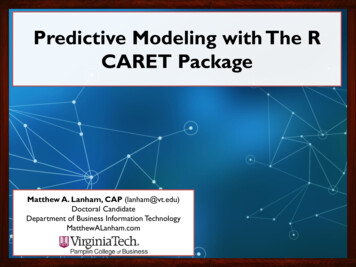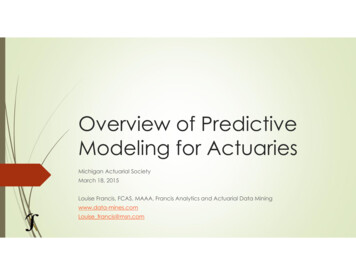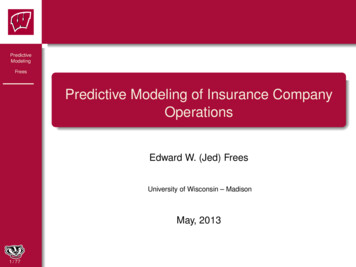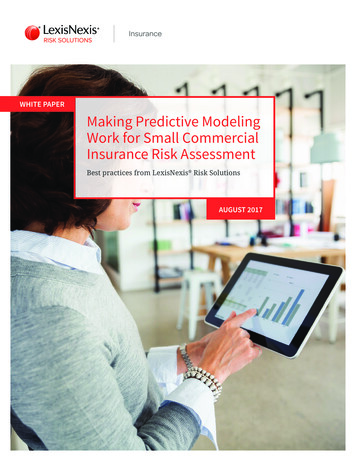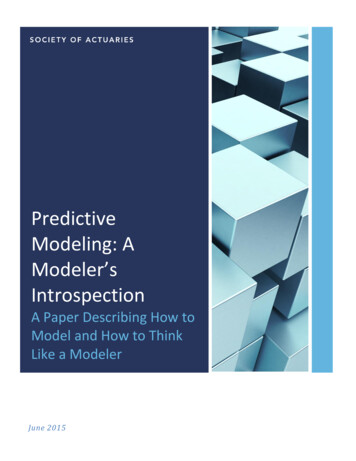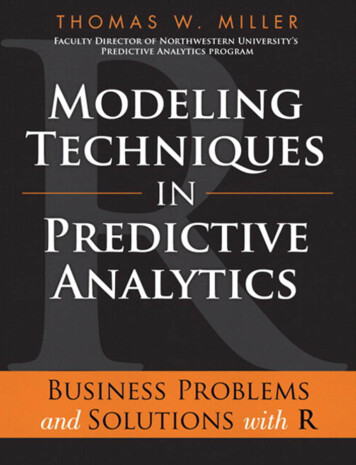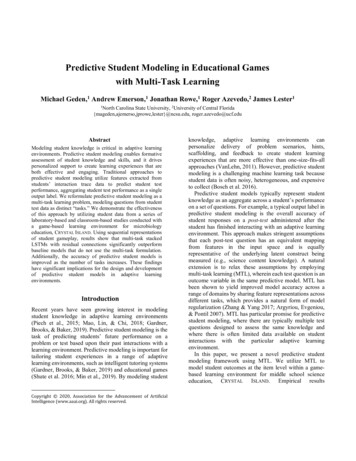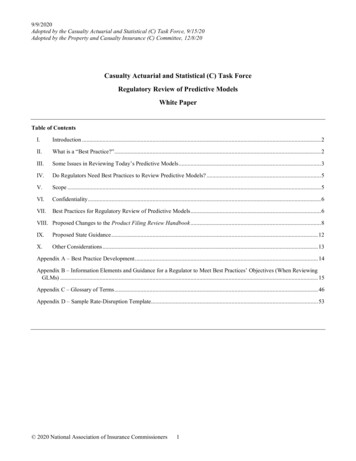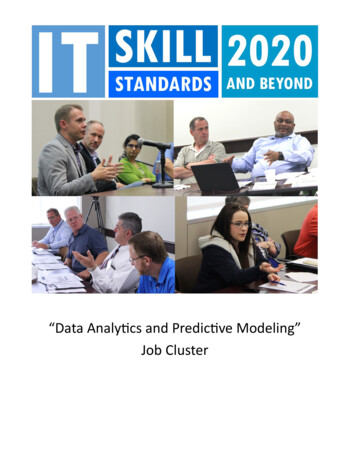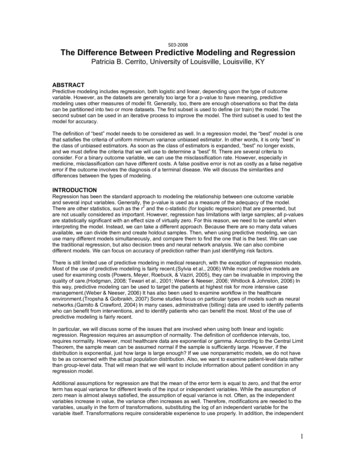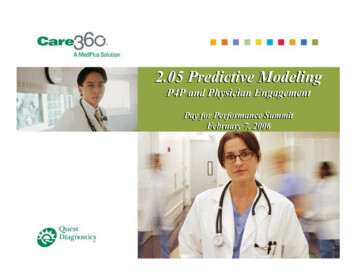
Transcription
2.05 Predictive ModelingP4P and Physician EngagementPay for Performance SummitFebruary 7, 20061
Agenda Three Key Healthcare Trends About “Predictive Modeling” About “Reporting” Business and Clinical Outcomes2
Healthcare Costs 3
Fragmented Information4
Quality ‘Gaps’ in Care“Our results indicate that, onaverage, Americans receiveabout half of recommendedcare processes.” - McGlynn, et.al,NEJM; June 26, 2003“Poor quality care leads to 65.5Mavoidable sick days and 1.8B inExcess Medical costs eachyear ”- State of Healthcare Quality: 2004** Source: www.NCQA.org/communications/somc/sohc2004.pdf5
Challenge: Chronic Disease Chronic Disease – 50-75% ofUS health care spend Chronic Diseases – 125mmAmericans with at least 1chronic disease, 45mm with 2chronic conditions Patients with chronic medicalconditions account for:– 76% of inpatient admissions– 88% of prescription drug use– 96% of home care visits– 72% of physician visitsSource: Chronic Conditions: Making the Case for Ongoing Care; December 2002; Partnership6for Solutions, Johns Hopkins University, for The Robert Wood Johnson Foundation
Opportunity: Chronic DiseasePopulation Contribution to Total Health Care Costs45%45%45%95%28%28%4%1%Membership27%27%Medical CostsSource: AC Monheit, “Persistence in Health Expenditures in the Short Run: Prevalenceand Consequences,” Medical Care 41, supplement 7 (2003): III53–III64.7
Role for Medical ManagementCovered Total Drug Avg. AnnualPopulationSpendCost/Case Participants90%1/31/39%1%1/3 1,200 6,600 71,600AcuteLow-GradeChronicHealthyDistribution EmergingChannels ManagementRetailPrevalent chronic(Asthma, Diabetes)Procedures(Childbirth,Surgery)Retail andMail OrderRare chronic(Hemophilia,Hepatitis C, MS,RSV, easeManagementCaseManagementSource: JP Morgan Industry Update, “Specialty Pharmacy: Conduit of Growth forBiotechnology,” March 14, 2003.8
Success Formula “Musts”1) Aggregate records of health care services2) Measure effectiveness of care:– Benchmark the process of care against medical evidence-basedmetrics– Benchmark the outcome of care against what is valued3) Establish valid economic correlates to the care– Use case-severity adjusted measures4) Use data mining and statistical analysis to predict whichindividuals will most benefit from proactive delivery ofservices5) Convey timely and accurate reporting to physicians6) Align financial incentives of stakeholders9
Objectives1.2.3.4.Understand uses of predictivemodeling as an applied science inhealth care deliveryCite how predictive modeling canadvance disease managementReview how predictive modeling canbe can be applied to pay forperformance programsCite specific steps for implementation10
Predictive Modeling: Definition The process of using predictive analytics toidentify a set of variables that can be combinedand used to forecast probabilities of an eventwith an acceptable level of reliability. Steps in creating a predictive model:1)2)3)4)Data is collectedA statistical model is formulatedPredictions are madeModel is validated (or revised) as additional data becomesavailable.11
Modeling Process Identify segments & select best drivers/variables Segments: Diseases, Enrollment Groups, Users, Benefit Class, Product LineVia Classification Methods Select model for optimum training of each segment Best Variables via: Decision Networks, Nearest Neighbor Pairing .,Linear & Nonlinear / Regression, Neural Networks .,Apply model on out-of-sample set for validation Sensitivity/specificity, R2Content experts evaluate results by reviewing variables across risk categoriesEach Client’s Population is evaluated against population parametersto determine Universal Model to deploy & whether optimization ofmodel is required12
Creating a Predictive ModelRaw DataTransformed VariablesMedicalClaims Episodes of care – Symmetry ETGRx Claims Drug Groupings - First DatabankMemberEligibilityOptional DataLab resultsHRAUM/AuthOutput - Risk MEDai clinical groupings Service timing/frequency Inpt/ER/Phys Patient characteristics Evidence Based Risk MarkersForecastedCosts foreachmemberRisk Score 1-5Relative RiskIndexMITCH ENGINE13
Validation Set Paid PM Predicted vs. ActualUse Year1 data to predict Year 2 cost18001600Actual 1400Predicted Paid 61656973778185Each data point represents a single group of members within a range of predicted paid amount fromthe lowest predicted group to the highest predicted group (100 groups each with 1100 members)89939714
Validation Set by Age Grouping Paid PM Predicted vs. Actual400350ACTUAL300PMPM 250PREDICTED2001501005001 3 5 7 9 11 13 15 17 19 21 23 25 27 29 31 33 35 37 39 41 43 45 47 49 51 53 55 57 59 61 63 65 67 69 71 73 75AGE15
Engage PhysiciansProviders need: Incentives – Pay For Performance Single point of access Complete patient historyMember / Risk / Impact ProfileAccess to Evidence based guidelines & referencesIdentify “gaps” in care for all patientsStratification of prospective risk for all patientsIdentify where to spend resource No disruption of day to day work flow16
17
18
19
Q20
21
22
23
SELECT24
25
26
27
28
29
30
31
32
33
What Does this Capability Mean for You? Physicians can focus on the proactive delivery of services that willhave a predictable impact on quality and cost No disruption to existing workflow An EMR or e-Prescribing software is not required to be in place Revolutionizes physician access to information: View of ALL thecare services irrespective of provider Better coordination of care between Health Plan and entireprovider network as well as between providers IPAs “at risk” are able to: Improve financial performance under the ‘cap’ in real timeValidate actuarial fairness of their capitation agreements34
Predictive Modeling & P4P Predictive modeling can be thought of as the“entry level” HIT system that can be adopted byany practicing physician with computer in theoffice Reporting is evidence based, transparent Enables P4P to connect the “process of care” tothe “clinical impact on outcomes” Ability to align incentives fairly and equitablyirrespective of the condition or severity of illness35
P4P Programs: Future PredictionsPredictive modeling will be used to administer“high-impact” P4P: Multi-payer reporting– Ability to address a physician’s entire practice Simultaneous, multi-cohort disease managementwith unified criteria (payer, QIO, CMS) Automated P4P, QIO & CMS reporting of outcomes Substantial financial incentives tied to “Quality” Automated “dash-board” reporting in real time Can be used to administer a more sophisticatedphysician payment system which reimburses forproactive care in both FFS and capitated plans36
CaveatsToday Seldom involves morethan one payer in apractice Enables multipleconditions to be trackedand managedsimultaneously and “atscale” Can be solely “payerdriven”Near Term Needs to involvereporting from all payers Need for payercoordination of the clinicalgoals in collaboration withphysicians Recommendcollaborative approachwith physicians and/orIPA governance andconsideration of positionsof organizations such asAmerican College ofPhysicians and others37
SummaryMedical claims, pharmacy utilization and clinicallaboratory information, can serve as valuable‘inputs’ into a predictive modeling engine toautomate reporting which will: Identify patients most likely to require medicalservices over the prospective benefit period Segregate of those with “impactable” risk Determine the most effective clinical course ofaction to mitigate acuity and cost of illness Support fair and equitable management of P4Pinitiatives “at scale”38
Thank you .Contacts:Patrick Tellez, MD, MPH, MSHAVice President, Medical AffairsMedPlus, a Quest Diagnostics Company4690 Parkway Dr.Mason, OH 45040513.229.5500ptellez@medplus.comRebecca HellmannPayer ServicesMedPlus, a Quest Diagnostics Company4690 Parkway Dr.Mason, OH 45040513.229.5500rhellmann@medplus.comFurther Reading:1) Predictive modeling: www.medai.com2) P4P Program Design:a) “Linking Physician Payments to Quality Care” American College of/Physicians Position Paper 2005; www.acponline.org hpp/link pay.pdfb) American Assn. Family Practice: http://www.aafp.org/x30307.xml39
Predictive Modeling: Definition The process of using predictive analytics to identify a set of variables that can be combined and used to forecast probabilities of an event with an acceptable level of reliability. Steps in creating a predictive model: 1) Data is collected 2) A statistical model is formulated 3) Predictions are made
